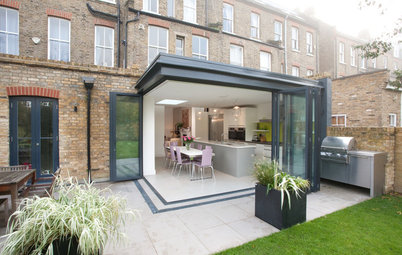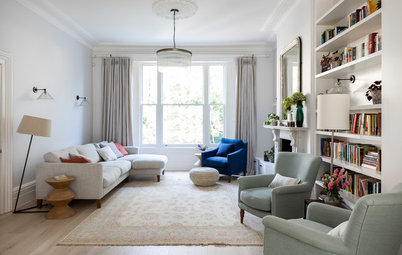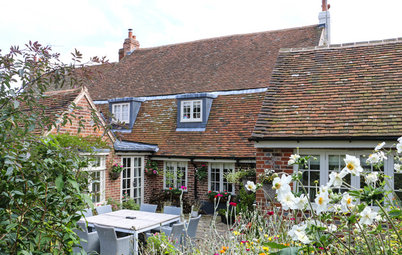Ask an Expert: How Do I Prepare a Property for Renting?
Before you rent out a property, you’ll need to make sure it’s appealing and safe for tenants
Being a landlord calls for more than offering a property to rent. You’ll need to invest time, effort and money to get that property to a safe and comfortable standard that will attract the right tenants and help you keep them. In fact, rushed design and décor jobs may mean you struggle to rent your property at all if it doesn’t appeal to tenants willing to pay the rent you need. Here, a group of experts give advice on transforming a rental property into one that tenants will want to call home.
Professional advice from: Hedie Yeganeh of Vivat Property | Phillip Pobgee of P&P Maintenance Services | Jemimah Barnett, property advisor
Professional advice from: Hedie Yeganeh of Vivat Property | Phillip Pobgee of P&P Maintenance Services | Jemimah Barnett, property advisor
Sort the storage and consider surfaces
You can help your tenants to keep your property in good condition by giving them plenty of storage. “Where possible, spend money on building in as much storage as possible, so that your tenants are able to keep the place tidy and organised with minimal fuss,” says property advisor Jemimah Barnett.
She also advises, for example, avoiding surfaces such as marble for worktops which can easily be stained by spills. “But do spend on decent – read, hard-wearing and nice-looking – worktops, bathrooms and floorings. These things take a real beating, so make sure they’re built to withstand that. Luckily, there are so many options these days that are really robust and affordable yet don’t compromise on style.”
The key dimensions to know when designing storage
You can help your tenants to keep your property in good condition by giving them plenty of storage. “Where possible, spend money on building in as much storage as possible, so that your tenants are able to keep the place tidy and organised with minimal fuss,” says property advisor Jemimah Barnett.
She also advises, for example, avoiding surfaces such as marble for worktops which can easily be stained by spills. “But do spend on decent – read, hard-wearing and nice-looking – worktops, bathrooms and floorings. These things take a real beating, so make sure they’re built to withstand that. Luckily, there are so many options these days that are really robust and affordable yet don’t compromise on style.”
The key dimensions to know when designing storage
Think long term
Where else should you invest? A decent branded boiler with a seven-year or more manufacturer’s warranty is well worth it, advises Pobgee: “There are cheaper boilers on the market, but once they’re out of the initial 12-month warranty they’ll start costing you a lot more and sour the relationship with the tenant.”
In terms of fittings, don’t go for the cheapest either. “It’s a false economy,” says Pobgee. “Not only that, cheap looks cheap. Remember, although this is your house, it’s somebody’s home. Create a decent environment and, by and large, they will look after it, will want to renew the tenancy and take a pride in their home. Do everything on the cheap and you may struggle to let the property.”
Pobgee also recommends updating soffits and fascias to UPVC. “It may cost a bit more now, but will save thousands of pounds in decorating costs over the next 20 years,” he says.
Where else should you invest? A decent branded boiler with a seven-year or more manufacturer’s warranty is well worth it, advises Pobgee: “There are cheaper boilers on the market, but once they’re out of the initial 12-month warranty they’ll start costing you a lot more and sour the relationship with the tenant.”
In terms of fittings, don’t go for the cheapest either. “It’s a false economy,” says Pobgee. “Not only that, cheap looks cheap. Remember, although this is your house, it’s somebody’s home. Create a decent environment and, by and large, they will look after it, will want to renew the tenancy and take a pride in their home. Do everything on the cheap and you may struggle to let the property.”
Pobgee also recommends updating soffits and fascias to UPVC. “It may cost a bit more now, but will save thousands of pounds in decorating costs over the next 20 years,” he says.
Be practical
Furniture shopping can be great fun, but it’s easy to get carried away. “Try to stay focused on the fact that whatever you buy must be practical as well as pretty, and ask yourself, ‘Would I be devastated if the tenants damaged this?’ If that’s the case, buy it for your own home but not your rental property,” Barnett suggests. Nevertheless, she recommends choosing good quality, hard-wearing pieces, especially for furniture that will be subject to plenty of wear and tear.
You can save on flooring, too, by choosing good-quality laminate. “Carpets aren’t practical in rentals and need regular replacing [so] go for mid- to top-end laminate boards,” suggests Barnett. “Laminate will also be more robust than real or engineered wood boards, which need regular care to stay in good shape. Go for stylish wide planks in a popular finish like washed oak and French grey.”
Furniture shopping can be great fun, but it’s easy to get carried away. “Try to stay focused on the fact that whatever you buy must be practical as well as pretty, and ask yourself, ‘Would I be devastated if the tenants damaged this?’ If that’s the case, buy it for your own home but not your rental property,” Barnett suggests. Nevertheless, she recommends choosing good quality, hard-wearing pieces, especially for furniture that will be subject to plenty of wear and tear.
You can save on flooring, too, by choosing good-quality laminate. “Carpets aren’t practical in rentals and need regular replacing [so] go for mid- to top-end laminate boards,” suggests Barnett. “Laminate will also be more robust than real or engineered wood boards, which need regular care to stay in good shape. Go for stylish wide planks in a popular finish like washed oak and French grey.”
Lighting also makes a huge impact on the look and feel of your rental property, but fortunately there’s no need to spend a fortune. Choose plain, tasteful shades for central pendants, which will provide general illumination, while low-level table lamps and floor lamps or even wall lamps, as here (choose designs that don’t need to be wired in for flexibility), help to create a warm, welcoming atmosphere. The tenants may end up having their own lamps, but for showing the property it’s a helpful touch, especially when viewings are so often in the evening. These don’t need to be expensive designer pieces; hunt around online for good-looking bargains or pick a very small model from a stylish shop.
Especially if you’re letting the place unfurnished – but even if you’re including lamps – dimmers are a nice addition because they can easily adapt to the time of day, event and mood. On a practical note, they can reduce energy consumption and increase bulb life, which could be a good selling point for prospective tenants looking to save money on bills.
Especially if you’re letting the place unfurnished – but even if you’re including lamps – dimmers are a nice addition because they can easily adapt to the time of day, event and mood. On a practical note, they can reduce energy consumption and increase bulb life, which could be a good selling point for prospective tenants looking to save money on bills.
Get landlord insurance
Landlord insurance is designed to protect you against damages to your asset. “Most property owners only have building insurance as it’s mandatory,” says Hedie Yeganeh of Vivat Property. But landlord insurance goes further and, depending on the package you choose, can also include liability insurance, fixtures and fittings insurance, cover for loss of rent, contents, alternative accommodation insurance, landlord legal expenses and more. “Surprisingly,” continues Yeganeh, “many homeowners are not informed as to how damages can be less costly by taking out [this type of insurance].”
Ask a property professional for guidance on finding a suitable insurance scheme.
Landlord insurance is designed to protect you against damages to your asset. “Most property owners only have building insurance as it’s mandatory,” says Hedie Yeganeh of Vivat Property. But landlord insurance goes further and, depending on the package you choose, can also include liability insurance, fixtures and fittings insurance, cover for loss of rent, contents, alternative accommodation insurance, landlord legal expenses and more. “Surprisingly,” continues Yeganeh, “many homeowners are not informed as to how damages can be less costly by taking out [this type of insurance].”
Ask a property professional for guidance on finding a suitable insurance scheme.
Take an inventory
Many landlords ask if they should take an inventory and the answer is: yes. “Taking a proper inventory (with photos) at the beginning of the tenancy lets your tenant know that you’re a good landlord who cares about the property’s condition and wishes to keep it in top shape,” says Barnett. “They’re then aware that this is the standard that’s expected, and are more likely to meet it.”
In addition to detailing the contents of the property, the inventory should list existing cosmetic blemishes, such as peeling wallpaper or flaking paint, along with any meter readings. “A visual record (taken in the presence of the tenant and signed by them) is by far the best way to encourage them to keep things in good order, and avoid conflict at checkout time if things have been damaged and need to be put right,” Barnett advises.
It’s best to be reasonable when it comes to expectations of your tenants. Some wear and tear is normal and inevitable in the course of daily life. “If your tenants wilfully or maliciously damage your property (or its contents) then you should seek redress from the deposit funds. If it’s some scuffs and marks here and there, that’s something to be expected and it’s part of the operating costs of being a good landlord,” says Barnett.
Many landlords ask if they should take an inventory and the answer is: yes. “Taking a proper inventory (with photos) at the beginning of the tenancy lets your tenant know that you’re a good landlord who cares about the property’s condition and wishes to keep it in top shape,” says Barnett. “They’re then aware that this is the standard that’s expected, and are more likely to meet it.”
In addition to detailing the contents of the property, the inventory should list existing cosmetic blemishes, such as peeling wallpaper or flaking paint, along with any meter readings. “A visual record (taken in the presence of the tenant and signed by them) is by far the best way to encourage them to keep things in good order, and avoid conflict at checkout time if things have been damaged and need to be put right,” Barnett advises.
It’s best to be reasonable when it comes to expectations of your tenants. Some wear and tear is normal and inevitable in the course of daily life. “If your tenants wilfully or maliciously damage your property (or its contents) then you should seek redress from the deposit funds. If it’s some scuffs and marks here and there, that’s something to be expected and it’s part of the operating costs of being a good landlord,” says Barnett.
Know the legal matters
Your obligations as a landlord go beyond fitting safe gas and electricity equipment – you also need to make sure that the equipment is checked annually by a registered engineer. Fire alarms and carbon monoxide alarms must be fitted, and failing to meet these standards can have serious consequences, including fines or even imprisonment.
You’ll also need an EPC – an Energy Performance Certificate. These are issued whenever a property is rented, sold or built. “An EPC, which is valid for 10 years, contains information about the property’s energy use, and standard costs and recommendations for the landlord on how to reduce energy consumption and save money,” explains Yeganeh.
The EPC must be carried out by an accredited assessor, and you’ll need to make it available to potential tenants. You can be fined for not having an EPC, so, as with safety matters, it’s best to get professional advice to make sure you’ve got everything right.
Your obligations as a landlord go beyond fitting safe gas and electricity equipment – you also need to make sure that the equipment is checked annually by a registered engineer. Fire alarms and carbon monoxide alarms must be fitted, and failing to meet these standards can have serious consequences, including fines or even imprisonment.
You’ll also need an EPC – an Energy Performance Certificate. These are issued whenever a property is rented, sold or built. “An EPC, which is valid for 10 years, contains information about the property’s energy use, and standard costs and recommendations for the landlord on how to reduce energy consumption and save money,” explains Yeganeh.
The EPC must be carried out by an accredited assessor, and you’ll need to make it available to potential tenants. You can be fined for not having an EPC, so, as with safety matters, it’s best to get professional advice to make sure you’ve got everything right.
Draw up a tenancy agreement
When a tenant agrees to rent your property, you must provide them with a tenancy agreement. This sets out in writing who’ll be living there, how much the rent they’ll pay is and any conditions the tenant needs to meet. The document should also include how the rent should be paid, start and end dates of the tenancy, and an outline of the bills for which the tenant is responsible.
You can find downloadable tenancy agreements online – the Residential Landlords Association (rla.org.uk) has a selection. Alternatively, ask a letting agent or solicitor to help you draw one up.
Do you have experience as a tenant or a landlord and tips to share? Do so in the Comments section.
When a tenant agrees to rent your property, you must provide them with a tenancy agreement. This sets out in writing who’ll be living there, how much the rent they’ll pay is and any conditions the tenant needs to meet. The document should also include how the rent should be paid, start and end dates of the tenancy, and an outline of the bills for which the tenant is responsible.
You can find downloadable tenancy agreements online – the Residential Landlords Association (rla.org.uk) has a selection. Alternatively, ask a letting agent or solicitor to help you draw one up.
Do you have experience as a tenant or a landlord and tips to share? Do so in the Comments section.























As a landlord, you have a legal duty to provide gas and electricity equipment and systems that are safe (and to provide proof of this – more of which shortly). Always use qualified installers: it’s simply not worth trying to cut costs when it comes to safety. Fire safety is also, of course, a priority – your local fire service will provide a free home check to advise you on the measures you’ll need to take, and to ensure a safe property, Building Regulations must be adhered to (read more later in this piece, and find out more at the Government’s Planning Portal).
Other parts of the property are worth spending on, too. For example: “Don’t skimp on bathroom tiling,” advises Phillip Pobgee of P&P Maintenance Services. “Tile all walls around a shower and bath, not just the bits you think will get wet. Overspray from a shower will damage walls, floors and decorations, and cost you a lot more than a couple of square metres of tiling.”
Ask your tradesperson to supply items as well as fit them – even for simple things such as taps. “It saves you the hassle of having to source them and tradespeople often get better prices,” Pobgee explains. “But more importantly, if you buy the taps and a tradesperson fits them and they go wrong after a couple of months, you will have to pay to replace them. If your tradesperson supplied them, it’s part of their contractual obligation to replace or repair them.”
Browse tiles in the Houzz Shop